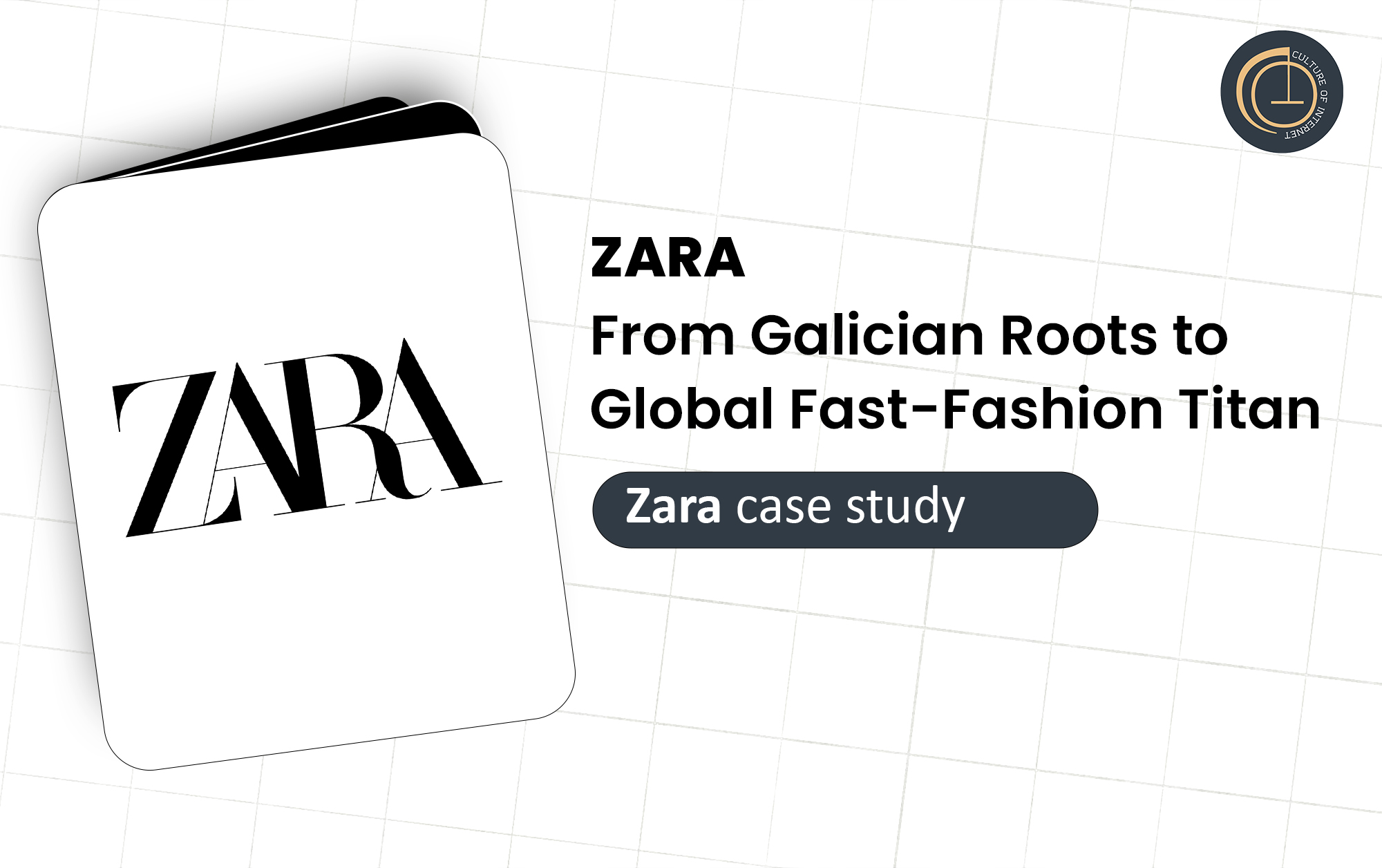Zara : Company Overview
ZARA is a globally renowned fast-fashion brand founded in 1975 in A Coruña, Galicia, Spain, by Amancio Ortega and Rosalía Mera. It began as a small clothing store with a simple vision—to bring high-fashion designs to the masses at affordable prices. Over time, ZARA evolved into the flagship brand of Inditex, the world’s largest fashion retailer, headquartered in Arteixo, Spain. Known for its trend-driven clothing, accessories, footwear, and home décor, ZARA operates nearly 3,000 stores in over 96 countries and maintains a powerful digital presence with online sales contributing 24% to total revenue in 2022.
A Humble Beginning in Spain
-
Zara opened its first store on May 9, 1975, in A Coruña, Galicia, Spain, founded by Amancio Ortega and his then-wife Rosalía Mera, building on their experience with Confecciones GOA (established in 1963) Originally called “Zorba,” the name was changed to Zara due to a nearby bar with the same name, adding an extra “A” from the unused signboard letters Zara began with an ambitious goal: offering high-fashion looks at affordable prices.
-
Their early model focused on copying high-end designs and fast-tracking them to store shelves. This democratization of fashion underpinned Zara’s brand ethos and set the scene for its unique business architecture
Pioneering the “Fast Fashion” Revolution
Unlike traditional retailers with months-long production cycles, Zara introduced an agile, fast-fashion model. This involved cutting lead times to mere weeks, entailing a rapid design-to-store process termed “instant fashion.
-
Vertical integration through parent company Inditex, formed in 1985—encompassing brands such as Zara, Bershka, and Massimo Dutti.
-
In-house and nearshore manufacturing (Spain, Portugal, Morocco, Turkey) allowing quick response to market demand—about 60% of garments are produced nearby .
-
A just-in-time inventory system with bi-weekly product restocking—Zara launches approximately 12,000 new designs annually , far surpassing typical competitors
Key elements of this model include :
This operational agility creates both consumer excitement and prudent inventory turnover, minimizing markdowns.
Explosive Global Expansion
Zara began international expansion in 1985 with a store in Porto, Portugal, followed by its entry into the U.S. market in 1989 (New York), and France in Through the 1990s and 2000s, rapid expansion followed across Mexico, Asia, South America, and the Middle East .
Key milestones include:
Inditex IPO on Madrid’s stock exchange—fueling global expansion
Initiation of e‑commerce in Spain; U.S. followed in 2011, with worldwide presence by 2020
Zara operates almost 3,000 stores in 96 countries, supported by powerful online infrastructure
Remarkably, Zara's sales in 2022 reached approximately €27.7 billion , with net income of €7 billion . Their global stores are located in prime urban areas, reinforcing both brand visibility and consumer footfall .
The Inditex Umbrella & Brand Diversification
Inditex, headquartered in Arteixo, Galicia, coordinates Zara and sister brands including Pull&Bear, Bershka, Massimo Dutti, Stradivarius, Oysho, and Zara Home .
-
1985 : - Inditex formed to oversee Zara and future brands.
-
2003 : - Launch of Zara Home, offering home textiles and décor; now operates over 400 stores in 44 countries .
-
No big ad spend—platform focus stays on optimal store locations and rapid assortment rotation
Key milestones :
A blend of fashion variety, vertical integration, and minimal advertising fosters brand discipline and profitability.
Supply Chain Innovation: From Greige to Global Distribution
Zara’s distinct supply chain is a model of industrial engineering excellence
-
Holding large stocks of greige fabric ready for immediate dyeing and cutting once designs are approved—this enables speed.
-
A powerful centralized distribution center in Spain, shipping globally within 48 hours.
-
Daily data collection via store managers and real-time sales analytics, feeding design and fabrication decisions .
Highlights include :
This logistical backbone underlies Zara's ability to replicate high-fashion trends in two to three weeks, a core differentiator in retail agility .
Pioneering Digital Transformation
Zara’s transition to omni‑channel retailing blends digital and physical experiences seamlessly.
-
2010 : Launch of online shopping, initially in Europe, expanding to the U.S. in 2011 and emerging markets later .
-
Incorporation of RFID technology around 2014, enhancing real-time inventory visibility .
-
Enhanced digital shopper experience—instant pick-up, integrated mobile payment, and online browsing tools synchronize with in-store availability.
Key moves :
In 2022, online channels represented 24% of Zara’s total revenue, signaling digital strategy success.
Sustainability & Ethical Challenges
Zara and Inditex have committed to 100% sustainable fabrics by 2025, waste reduction, and zero-waste store operations
-
Launch of eco-aware collections (2010s onwards), coupled with sustainable sourcing
-
At Inditex's 2023 AGM, new goals to reduce emissions by 50% by 2030 and reach net zero by 2040.
-
Zara Home opened its first eco-store in 2012 .
Key achievements:
However, clothing production in countries like Bangladesh, Vietnam, and Turkey has drawn criticism for labor issues—unsafe conditions, low wages, and long hours
Additionally, advertising missteps—such as insensitive designs—have brought scrutiny and highlighted risks of rapid product cycles
Zara has responded by intensifying supply chain audits, supporting transparent factories, and updating internal guidelines.
Leadership: Transition to a New Generation
-
Amancio Ortega remains a foundational pillar—his net worth reaching approximately €103 billion by 2024—with Inditex as Spain’s most valuable listed company.
-
In December 2021, Ortega’s daughter Marta Ortega Pérez became Chairperson of Inditex, officially taking over in April 2022. Previously involved in operations and product design, she is credited with steering the company through reputation issues related to labor and environmental impact . .
-
Under her leadership, emphasis has doubled down on sustainability, digital integration, and maintaining cultural relevance. The transition signals a generational passage from founder to heir-led continuity.
Financial Performance & Market Position
Zara’s financial prowess is evident :
-
2022 revenue: €27.7 billion, net profit: €7 billion—a 36% and 86% increase year-over-year respectively.
-
Online sales contributed 24% of total .
-
FY25 India operations saw ₹2,782 crore in revenue (+0.5%) and ₹299 crore net profit (+23%)—reflecting strong margins although steady topline.
Zara remains the flagship brand of Inditex, which is the world’s largest fashion retailer by revenue , outperforming rivals like H&M .
Its blend of brand positioning, omnichannel retail, localized supply, and aggressive growth cements Zara’s high market status.
Cultural Impact & Future Trajectory
Zara has reshaped fashion consumption—moving runway trends into accessible, affordable offerings within weeks. The brand has collaborated with designers and influencers, occasionally drawing critical acclaim
Cultural relevance: Zara is worn by celebrities and royalty. In the UK, the Princess of Wales has been spotted in Zara pieces . High-profile associations—from Kate Moss and Cindy Crawford to Stefano Pilati—target a sophisticated audience
Challenges: Fierce competition from ultra-fast fashion players like Shein and Temu strains Zara’s model; consumer attitudes are shifting toward "buy less, buy better" .
Future direction :
-
Deepening sustainability goals beyond 2025 ambitions.
-
Expanding digital integration—personalization, virtual fitting, RFID. .
-
Refined site selection—balancing store presence vs. rental cost efficiency .
-
Retaining cultural cachet via influencer marketing and premium-tier collaborations. .
Conclusion: Zara’s Ongoing Global Influence
From a modest store in Galicia, Zara has revolutionized fashion—transforming trend cycles, retail logistics, and consumer expectations. By pioneering ultra-responsive supply chains, vertical integration, digital channels, and low advertising overhead, the brand has maintained robust profitability and global footprint.
Nevertheless, meeting sustainability obligations and managing fast-fashion-related criticism remain ongoing obstacles. With Marta Ortega at the helm and a dual focus on ecological responsibility and digital immersion, Zara appears ready for its next growth phase.
As global fashion continues to evolve, Zara’s 50‑year journey underscores the power of agility and customer-centric design. Its story is far from over—but its past achievements underscore why it remains central to the conversation around modern retail.
References & Further Reading
For more depth on Zara’s 50th anniversary celebrations, store milestones, and India performance, explore the following recent articles:
Related news on Zara’s growth & milestones.
Explore Our Comprehensive Marketing Strategy Course
Join our in-depth course to master Zara India's marketing strategies, learn from expert case studies, and gain actionable insights to apply in your own business or career.









